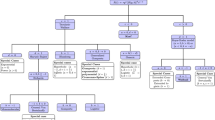Abstract
The rate of growth of an organism may be described as a function of both its mass and of the time. In particular, if the rate of growth is described as a function of mass alone, one derives the so-called principle of “equifinality”, according to which the final mass achieved is independent of any interruption of the growth process. Since this phenomenon is observed in many instances, the assumption that the rate of growth is a function of mass alone has some theoretical justification. On the other hand, it is obvious that in many instances irreversible effects can be achieved by interrupting the growth process, thus indicating that the rate of growth may depend on variables other than mass. The consequences of some of these alternative assumptions are examined. A growth factorG is postulated, which is supposed to decay with time, and whose concentration determines the over-all rate of growth per unit mass. The rate of decay ofG is calculated from the postulated growth equation under two alternative assumptions, (1) thatG is a constituent of all the cells of the organism and (2) thatG is produced separately and distributed through the organism. It is shown that in each case the concentration ofG satisfies a simple differential equation. While in normal growth the results deduced from these hypotheses are indistinguishable from those deduced from the assumption that the rate of growth depends on mass alone, widely different results are obtained in the case of interrupted growth. In particular, the rate at which growth is resumed after interruption and the final mass achieved depend on the time and on the duration of interruption. It appears, therefore, that various assumptions about the nature of the “aging” of the organism lead to various quantitative relations between growth and the times of interruption and resumption of growth.
Similar content being viewed by others
Literature
Bertalanffy, Ludwig von. 1951.Theoretische Biologie. Second ed., completely revised. Bern: A. Francke AG Verlag.
Gerard, R. W. 1940.Unresting Cells. New York and London: Harper Bros.
Mendel, L. B. 1923.Nutrition: The Chemistry of Life. New Haven: Yale University Press.
Author information
Authors and Affiliations
Rights and permissions
About this article
Cite this article
Rapoport, A. Some theoretical consequences of the allometric growth equations. Bulletin of Mathematical Biophysics 17, 155–167 (1955). https://doi.org/10.1007/BF02477856
Received:
Issue Date:
DOI: https://doi.org/10.1007/BF02477856




